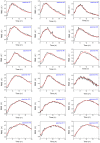Postmortem Electrical Conductivity Changes of Dicentrarchus labrax Skeletal Muscle: Root Mean Square (RMS) Parameter in Estimating Time since Death
- PMID: 35565489
- PMCID: PMC9105913
- DOI: 10.3390/ani12091062
Postmortem Electrical Conductivity Changes of Dicentrarchus labrax Skeletal Muscle: Root Mean Square (RMS) Parameter in Estimating Time since Death
Abstract
Electric impedance spectroscopy techniques have been widely employed to study basic biological processes, and recently explored to estimate postmortem interval (PMI). However, the most-relevant parameter to approximate PMI has not been recognized so far. This study investigated electrical conductivity changes in muscle of 18 sea bass specimens, maintained at different room temperatures (15.0 °C; 20.0 °C; 25.0 °C), during a 24 h postmortem period using an oscilloscope coupled with a signal generator, as innovative technology. The root mean square (RMS) was selected among all measured parameters, and recorded every 15 min for 24 h after death. The RMS(t) time series for each animal were collected and statistically analyzed using MATLAB®. A similar trend in RMS values was observed in all animals over the 24 h study period. After a short period, during which the RMS signal decreased, an increasing trend of the signal was recorded for all fish until it reached a peak. Subsequently, the RMS value gradually decreased over time. A strong linear correlation was observed among the time series, confirming that the above time-behaviour holds for all animals. The time at which maximum value is reached strongly depended on the room temperature during the experiments, ranging from 6 h in fish kept at 25.0 °C to 14 h in animals kept at 15.0 °C. The use of the oscilloscope has proven to be a promising technology in the study of electrical muscle properties during the early postmortem interval, with the advantage of being a fast, non-destructive, and inexpensive method, although more studies will be needed to validate this technology before moving to real-time field investigations.
Keywords: Dicentrarchus labrax; PMI; RMS; electrical conductivity; postmortem interval; skeletal muscle; teleost.
Conflict of interest statement
The authors declare no conflict of interest.
Figures







References
-
- Perper J. Time of death and changes after death. In: Spitz W.U., Spitz D.J., editors. Medicolegal Investigation of Death: Guidelines for the Application of Pathology to Crime Investigation. 4th ed. Charles C. Thomas; Springfield, IL, USA: 2006. pp. 87–183.
LinkOut - more resources
Full Text Sources

